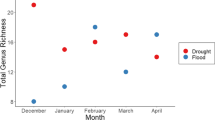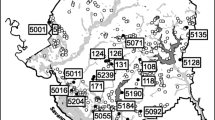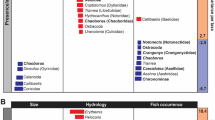Abstract
We measured aquatic invertebrate abundance, standing stock biomass, and community production in three types of wetlands on Noxubee National Wildlife Refuge from December 1987 through April 1988. Together,Orthocyclops modestus andDaphnia pulex were the most abundant organisms collected in all habitats during both winter and spring, but each contributed little to total standing stock biomass or production.Caecidotea communis andPristina osborni made up ≥47% of the total standing stock biomass at each site during both winter (December–February) and spring (March–May).Crangonyx gracilis, Chironomus spp.,Chaoborus punctipennis, andEclipidrilus spp. each contributed ≥5% of the total biomass at one or more wetland habitats. Estimates of aquatic invertebrate community production ranged from 930 to 1,578 mg dry weight/m2 among wetland types during winter and from 3,306 to 5,421 mg dry weight/m2 among wetland types during spring.Caecidotea communis andPristina osborni contributed most to community production during both seasons, but particularly in beaver ponds during spring. Other taxa made up substantial portions of the community production in one or two wetland habitats.
Similar content being viewed by others
Literature Cited
Analytical Software. 1992. Statistix. Analytical Software, St. Paul, MN, USA.
Arner, D.H., E.D. Norwood, and B.M. Teels. 1969. Comparison of aquatic ecosystems in two national waterfowl refuges. Proceedings of the Southeastern Association of Game and Fish Commissioners 28:456–467.
Baterna, D.L., G.S. Henderson, and L.H. Fredrickson. 1985. Wetland invertebrate distribution in bottomland hardwoods as influenced by forest type and flooding regime. p. 196–202.In J.O. Doson and K.A. Majerus (eds.) Proceedings of the 5th Central Hardwood Conference. University of Illinois, Department of Forestry, Champaign/Urbana, IL, USA.
Batzer, D.P. and V.H. Resh. 1992. Macroinvertebrates of a California seasonal wetland and responses to experimental habitat manipulation. Wetlands 12:1–7.
Benke, A.C. 1984. Secondary production of aquatic insects. p. 289–322.In V.H. Resh and D. M. Rosenberg (eds.) The Ecology of Aquatic Insects. Praeger Publishers, New York, NY, USA.
Benke, A.C., T.C. Van Arsdall, Jr., D.M. Gillespie, and F.K. Parrish. 1984. Invertebrate productivity in a subtropical blackwater river: the importance of habitat and life history. Ecological Monographs 54:25–63.
Brent, F.V., Jr. 1986. Soil survey of Noxubee County, Mississippi. U.S. Department of Agriculture, Soil Conservation Service. Washington, DC, USA.
Bryan, C.F., D.J. DeMont, D.S. Sabins, and J.P. Newman, Jr. 1976. A limnological survey of the Atchafalaya Basin. Annual Report, Louisiana Cooperative Fishery Research Unit, Louisiana State University, Baton Rouge, LA, USA.
Butler, M.G. 1984. Life histories of aquatic insects. p. 24–55.In V.H. Resh and D.M. Rosenberg (eds.) The Ecology of Aquatic Insects. Praeger Publishers, New York, NY, USA.
Drobney, R.D. and L.H. Fredrickson. 1979. Food selection by wood ducks in relation to breeding status. Journal of Wildlife Management 43:109–120.
Elliott, J.M. 1977. Some methods for the statistical analysis of samples of benthic invertebrates, second edition. Scientific Publication number 25, Freshwater Biological Association, Ferry House, Ambleside, UK.
Fisher, S.G. and L.J. Gray. 1983. Secondary production and organic matter processing by cellector macroinvertebrates in a desert stream. Ecology 64:1217–1224.
Gladden, J.E. and L.A. Smock. 1990. Macroinvertebrate distribution and production on the floodplain of two lowland headwater streams. Freshwater Biology 24:533–545.
Heitmeyer, M.E. 1985. Wintering strategies of female mallards related to dynamics of lowland hardwood wetlands in the upper Mississippi Delta. Ph.D. Dissertation. University of Missouri. Columbia, MO, USA.
Martien, R.F. and A.C. Benke. 1977. Distribution and production of two crustaceans in a wetland pond. The American Midland Naturalist 98:162–175.
Miller, A.C. and C.R. Bingham. 1987. A hand-held benthic core sampler. Journal of Freshwater Ecology 4:77–81.
Reid, F.A., J.R. Kelley, Jr., T.S. Taylor, and L.H. Fredrickson. 1989. Upper Mississippi Valley wetlands—refuges and moist soil impoundments. p. 181–202.In L.M. Smith, R.C. Pederson, and R.M. Kaminski (eds.) Habitat Management for Migrating and Wintering Waterfowl in North America. Texas Tech University Press, Lubbock, TX, USA.
Reinecke, K.J., R.M. Kaminski, D.J. Moorhead, J.D. Hodges, and J.R. Nassar. 1989. Mississippi Alluvial Valley. p. 203–248.In L.M. Smith, R.C. Pederson, and R.M. Kaminski (eds.) Habitat Management for Migrating and Wintering Waterfowl in North America. Texas Tech University Press, Lubbock, TX, USA.
Sklar, F.H. 1985. Seasonality and community structure of the back-swamp invertebrates in cypress-tupelo wetland. Wetlands 5:69–86.
Sniffen, R.P. 1981. Benthic invertebrate production during seasonal inundation of a flood plain swamp. Ph.D. Dissertation, University of North Carolina. Chapel Hill, NC, USA.
Waters, T.F. 1977. Secondary production in inland waters. Advances in Ecological Research 10:91–164.
Wetzel, R.L. 1983. Limnology, second edition. W.B. Saunders Co., Philadelphia, PA, USA.
Wetzel, R.L. and G.E. Likens. 1979. Limnological Analysis. Saunders Publishing, Philadelphia, PA, USA.
Wharton, C.H., V.S. Lambou, J. Newsom, P.V. Winger, L.L. Gaddy, and R. Mancke. 1981. The fauna of bottomland hardwoods in Southeastern United States. p. 87–160.In Wetlands of bottomland hardwood forests. Proceedings of a Workshop on Bottomland Hardwood Forest Wetlands of Southeastern United States. Elsevier Scientific Publishing, New York, NY, USA.
Wharton, C.H., W.M. Kitchens, E.C. Pendleton, and T.W. Sipe. 1982. The ecology of bottomland hardwood swamps of the south-east: a community profile, U.S. Fish and Wildlife Service, Office of Biological Services, Washington, DC, USA. FWS/OBS-81/37.
White, D.C. 1985. Lowland hardwood wetland invertebrate community and production in Missouri. Archives für Hydrobiologia 103:509–533.
Author information
Authors and Affiliations
Rights and permissions
About this article
Cite this article
Duffy, W.G., LaBar, D.J. Aquatic invertebrate production in southeastern USA wetlands during winter and spring. Wetlands 14, 88–97 (1994). https://doi.org/10.1007/BF03160625
Received:
Revised:
Accepted:
Issue Date:
DOI: https://doi.org/10.1007/BF03160625




